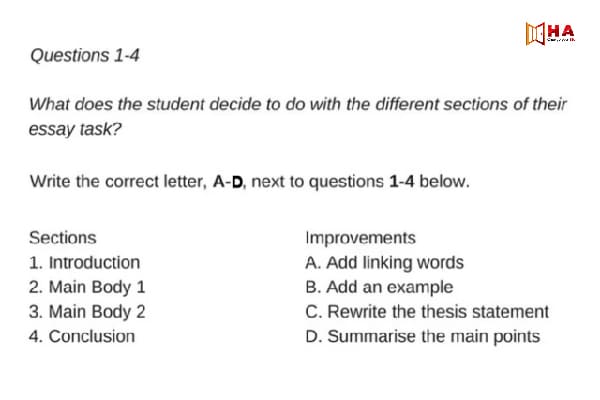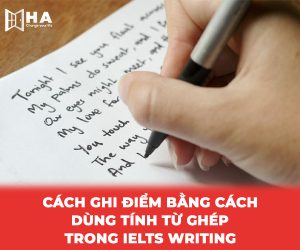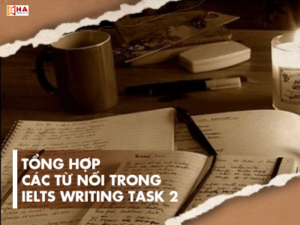Đối với mỗi dạng bài trong IELTS READING, chúng ta lại phải có chiến lược làm bài rõ ràng để không bị luống cuống và bỏ lỡ bất kỳ thông tin nào trong bài. Một trong những dạng bài phổ biến trong Reading là Matching Feature. Vậy matching features là gì, cách làm dạng bài này ra sao? Hôm nay HA CENTRE sẽ hướng dẫn các bạn chiến thuật làm dạng bài Matching Feature một cách thông minh nhất nhé!

Một ví dụ về dạng bài matching feature
1. Tổng quan dạng bài Matching Feature
Matching Feature là dạng thường gặp trong bài IELTS Reading. Đề bài cung cấp các danh từ riêng, bạn có nhiệm vụ nối chúng với những câu mang thông tin miêu tả đặc điểm nổi bật nhất của danh từ đó.
2. Format dạng bài Matching Feature
Bài đọc sẽ đề cập đến những tên riêng về những nhân vật liên quan đến 1 chủ đề nào đó. Sau đó là phần câu hỏi cung cấp với hai mục là một câu/đoạn văn và đặc điểm để bạn lựa chọn nối phù hợp. Bài thi đánh giá khả năng nhận dạng mối liên hệ giữa các kết nối bài, có thể tìm ra các thông tin chi tiết của bài nhanh chóng.
3. Những vấn đề thường mắc phải khi làm Matching Feature
Khi làm dạng bài này, thí sinh thường hay mắc phải những lỗi dưới đây:
- Đọc hết toàn bộ bài đọc: Điều này thực tế với những ai mới học Reading và không có nhiều kỹ năng đều mắc phải. Bạn nên học cách Scan để tìm thông tin thì sẽ hiệu quả hơn.
- Không đọc kỹ những phần chứa thông tin mà chỉ đoán từ
- Không chú ý đến các từ đồng nghĩa, chỉ chú trọng các từ chính xác
- Với dạng bài này, câu hỏi sẽ không theo trật tự vì thế các bạn cần chú ý.
4. Chiến thuật, cách làm bài Matching Feature
- Tập trung vào tên (names), ngày tháng (dates); nơi chốn (places)
- Scan đoạn văn để tìm tên và gạch chân vào đoạn văn khi xuất hiện các tên đó
- Đọc câu hỏi kỹ càng trước
- Đọc bài đọc cẩn thận và tìm từ đồng nghĩa
- Gạch dưới những câu chứa câu trả lời
- Với những đáp án bạn đã chắc chắn, hãy gạch chúng khỏi đề để loại được bớt những phương án cần cân nhắc
5. Luyện tập dạng câu hỏi Matching Feature IELTS Reading
Storytelling, From Prehistoric, Craves To Modern Cinemas
A It was told, we suppose, to people crouched around a fire: a tale of adventure, most likely—relating some close encounter with death: a remarkable hunt, an escape from mortal danger; a vision, or something else out of the ordinary. Whatever its thread, the weaving of this story was done with a prime purpose. The listeners must be kept listening. They must not fall asleep. So, as the story went on, its audience should be sustained by one question above all: What happens next?
B The first fireside stories in human history can never be known. They were kept in the heads of those who told them. This method of storage is not necessarily inefficient. From documented oral traditions in Australia, the Balkans, and other parts of the world we know that specialized storytellers and poets can recite from memory literally thousands of lines, in verse or prose, verbatim – word for word. But while memory is rightly considered an art in itself, it is clear that a primary purpose of making symbols is to have a system of reminders or mnemonic cues – signs that assist us to recall certain information in the mind’s eye.
C In some Polynesian communities, a notched memory stick may help to guide a storyteller through successive stages of recitation. But in other parts of the world, the activity of storytelling historically resulted in the development or even the invention of writing systems. One theory about the arrival of literacy in ancient Greece, for example, argues that the epic tales about the Trojan War and the wanderings of Odysseus traditionally attributed to Homer were just so enchanting to hear that they had to be preserved. So the Greeks, c. 750-700BC. borrowed an alphabet from their neighbors in the eastern Mediterranean, the Phoenicians.
D The custom of recording stories on parchment and other materials can be traced in many manifestations around the world, from the priestly papyrus archive of ancient Egypt to the birch-bark scrolls on which the North American Ojibway Indians set down their creation myth. It is a well-tried and universal practice: so much so that to this day storytime is probably most often associated with words on paper. The formal practice of narrating a story aloud would seem-so we assume-to have given way to newspapers, novels, and comic strips. This, however, is not the case. Statistically, it is doubtful that the majority of humans currently rely upon the written word to get access to stories. So what is the alternative source?
E Each year, over 7 billion people will go to watch the latest offering from Hollywood. Bollywood and beyond. The supreme storyteller of today is cinema. The movies, as distinct from still photography, seem to be an essentially modern phenomenon. This is an illusion, for there are, as we shall see, certain ways in which the medium of film is indebted to very old precedents of arranging ‘sequences’ of images. But any account of visual storytelling must begin with the recognition that all storytelling beats with a deeply atavistic pulse: that is, a ‘good story’ relies upon formal patterns of plot and characterization that have been embedded in the practice of storytelling over many generations.
F Thousands of scripts arrive every week at the offices of the major film studios. But aspiring screenwriters really need to look no further for essential advice then the fourth-century BC Greek Philosopher Aristotle. He left some incomplete lecture notes on the art of telling stories in various literary and dramatic modes, a slim volume known as the Poetics. Though he can never have envisaged the popcorn-fuelled actuality of a multiplex cinema, Aristotle is almost prescient about the key elements required to get the crowds flocking to such a cultural hub. He analyzed the process with cool rationalism. When a story enchants us, we lose the sense of where we are; we are drawn into the story so thoroughly that we forget it is a story being told. This is. in Aristotle’s phrase, ‘the suspension of disbelief.
G We know the feeling. If ever we have stayed in our seats, stunned with grief, as the credits roll by, or for days after seeing that vivid evocation of horror have been nervous about taking a shower at home, then we have suspended disbelief. We have been caught, or captivated, in the storyteller’s wet). Did it all really happen? We really thought so for a while. Aristotle must have witnessed often enough this suspension of disbelief. He taught at Athens, the city where theater developed as a primary form of civic ritual and recreation. Two theatrical types of storytelling, tragedy, and comedy, caused Athenian audiences to lose themselves in sadness and laughter respectively. Tragedy, for Aristotle, was particularly potent in its capacity to enlist and then purge the emotions of those watching the story unfold on the stage, so he tried to identify those factors in the storyteller’s art that brought about such engagement. He had, as an obvious sample for analysis, not only the fifth-century BC masterpieces of Classical Greek tragedy written by Aeschylus. Sophocles and Euripides. Beyond them stood Homer. whose stories oven then had canonical status: The Iliad and The Odyssey were already considered literary landmarks-stories by which all other stories should be measured. So what was the secret of Homer’s narrative art?
H It was not hard to find. Homer created credible heroes. His heroes belonged to the past, they were mighty and magnificent, yet they were not, in the end, fantasy figures. He made his heroes sulk, bicker, cheat, and cry. They were, in short, characters-protagonists of a story that an audience would care about, would want to follow, would want to know what happens next. As Aristotle saw, the hero who shows a human side some flaw or weak-ness to which mortals are prone is intrinsically dramatic.
Questions 1-4
Classify the following information as referring to
| A | B | C |
| adopted the writing system from another country | used organic materials to record stories | used tools to help to tell stories |
Write the correct letter, A, B or C in boxes 1-4 on your answer sheet.
1 ___ Egyptians
2 ____ Ojibway
3 ____ Polynesians
4 ____ Greek
Đáp án: B – B – C – A
Mong rằng những thông tin HA CENTRE chia sẻ sẽ có ích đối với bạn. Nếu bạn còn thắc mắc hoặc có nhu cầu học IELTS, hãy liên hệ ngay với HA Centre theo số điện thoại MR. HA: 0963 07 2486, HOTLINE 1: 032 796 3868, HOTLINE 2: 032 976 3868 để được giải đáp nhanh nhất nhé!

















